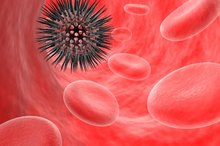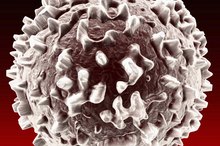What does fact checked mean?
At Healthfully, we strive to deliver objective content that is accurate and up-to-date. Our team periodically reviews articles in order to ensure content quality. The sources cited below consist of evidence from peer-reviewed journals, prominent medical organizations, academic associations, and government data.
The information contained on this site is for informational purposes only, and should not be used as a substitute for the advice of a professional health care provider. Please check with the appropriate physician regarding health questions and concerns. Although we strive to deliver accurate and up-to-date information, no guarantee to that effect is made.
Blood Cell Count & Infections
The blood cell count is a laboratory test that checks the levels of three types of cells: the red blood cells, which carry oxygen to the body’s tissues; the platelets, which help clot off blood; and the white blood cells, which fight infections. The cell count is a valuable lab work that health providers use to screen for infections, inflammation and allergic reactions.
If you are experiencing serious medical symptoms, seek emergency treatment immediately.
Types
According to MedlinePlus, there are five types of white blood cells, also known as leukocytes, which are the cells that fight infections: basophils, eosinophils, lymphocytes, monocytes and neutrophils. Each of these cell types has a specific function. Neutrophils usually fight off bacterial infections; eosinophils can be elevated during allergic reactions or parasitic infections; lymphocytes can be elevated in viral infections; monocytes help fight viruses, parasites and infections such as tuberculosis; and basophils are involved in the body’s allergic response.
Effects
A High Number of Leukocytes
Learn More
During an infection, your body produces a greater number of white blood cells. This is called leukocytosis. Depending on the type of infection, one of the specific white blood cell types may be elevated more than others. For example, during bacterial infections, neutrophils are elevated. During serious bacterial infections, the body starts producing neutrophils so fast that it starts to put into the bloodstream immature neutrophils, called bands. A high number of bands is called bandemia or a left-shift in the cell count.
- During an infection, your body produces a greater number of white blood cells.
- A high number of bands is called bandemia or a left-shift in the cell count.
Function
The white blood cells work in concert with the immune system when the body detects an infection. The bone marrow produces them and increases or decreases their numbers as needed. According to the Puget Sound Blood Center, when an infection appears in the bloodstream, lymphocytes produce antibodies that mark the invading pathogens for destruction by neutrophils and monocytes. The macrophages, a form of monocyte, actually engulf bacteria and destroy them with various chemicals and enzymes.
- The white blood cells work in concert with the immune system when the body detects an infection.
Significance
What Is a Shift to the Left in Blood Testing?
Learn More
Another effect of certain infections is to lower the white blood cell count. A decrease in the level of white blood cells is called leucopenia. According to MedlinePlus, infections with certain viruses, such as parvovirus, can suppress the production of these cells in the bone marrow. A decrease in the number of neutrophils, called neutropenia, can hinder the body’s defenses. This can lead to serious bacterial infections.
- Another effect of certain infections is to lower the white blood cell count.
- A decrease in the number of neutrophils, called neutropenia, can hinder the body’s defenses.
Warning
Although infections are one of the most common causes of an increase in white blood cells levels, other conditions can cause the same reaction. For example, leukemia, a cancer of the white blood cells, can present with abnormalities in the number and function of these cells. In fact, frequent or recurrent infections are one of the main symptoms of leukemia.
Related Articles
References
- Medline Plus: WBC count
- Mayadas TN, Cullere X, Lowell CA. The multifaceted functions of neutrophils. Annu Rev Pathol. 2014;9:181-218. doi:10.1146/annurev-pathol-020712-164023
- Mcbrien CN, Menzies-gow A. The Biology of Eosinophils and Their Role in Asthma. Front Med (Lausanne). 2017;4:93. doi:10.3389/fmed.2017.00093
- Cromheecke JL, Nguyen KT, Huston DP. Emerging role of human basophil biology in health and disease. Curr Allergy Asthma Rep. 2014;14(1):408. doi:10.1007/s11882-013-0408-2
- Hoffman W, Lakkis FG, Chalasani G. B Cells, Antibodies, and More. Clin J Am Soc Nephrol. 2016;11(1):137-54. doi:10.2215/CJN.09430915
- Karlmark KR, Tacke F, Dunay IR. Monocytes in health and disease - Minireview. Eur J Microbiol Immunol (Bp). 2012;2(2):97-102. doi:10.1556/EuJMI.2.2012.2.1
- Görgens A, Radtke S, Horn PA, Giebel B. New relationships of human hematopoietic lineages facilitate detection of multipotent hematopoietic stem and progenitor cells. Cell Cycle. 2013;12(22):3478-82. doi:10.4161/cc.26900
- Hong JW, Noh JH, Kim DJ. Association between White Blood Cell Counts within Normal Range and Hemoglobin A1c in a Korean Population. Endocrinol Metab (Seoul). 2018;33(1):79-87. doi:10.3803/EnM.2018.33.1.79
- Riley LK, Rupert J. Evaluation of Patients with Leukocytosis. Am Fam Physician. 2015;92(11):1004-11.
- Flores-mireles AL, Walker JN, Caparon M, Hultgren SJ. Urinary tract infections: epidemiology, mechanisms of infection and treatment options. Nat Rev Microbiol. 2015;13(5):269-84. doi:10.1038/nrmicro3432
- Kasi PM, Grothey A. Chemotherapy-Induced Neutropenia as a Prognostic and Predictive Marker of Outcomes in Solid-Tumor Patients. Drugs. 2018;78(7):737-745. doi:10.1007/s40265-018-0909-3
- U.S. Library of Medicine. MedlinePlus. White Blood Cell Count. https://medlineplus.gov/ency/article/003643.htm
Writer Bio
Ruben J. Nazario has been a medical writer and editor since 2007. His work has appeared in national print and online publications. Nazario is a graduate of the University of Louisville School of Medicine, and is board-certified in pediatrics. He also has a Master of Arts in liberal studies from Skidmore College in Saratoga Springs, N.Y.








